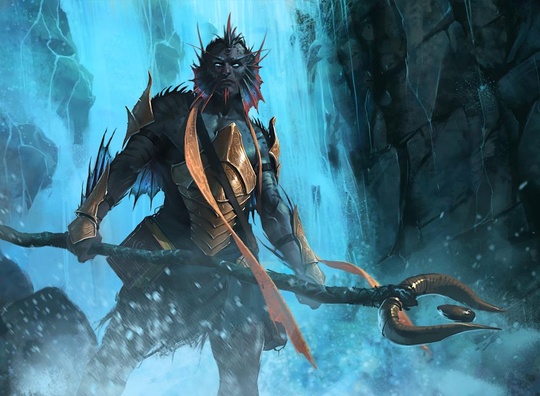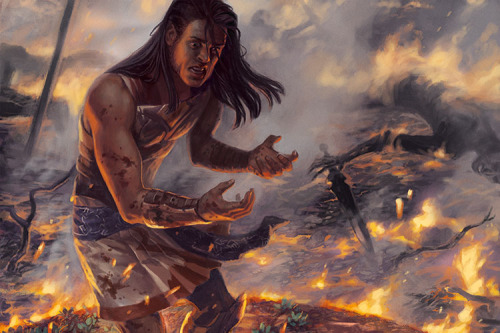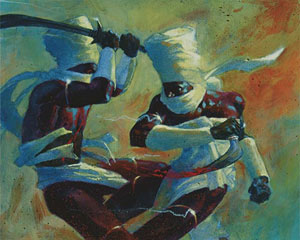Grand Prix Dallas is in the books and Pro Tour Magic Origins is upon us. I had a great time competing in Dallas and learned tons about the Origins limited format. I struggled in the sealed main event on Saturday with a combination of a mediocre pool and some inexcusable play errors. Sunday brought redemption as I crushed two side event drafts.
Dallas taught me three big lessons. The first two relate to the Origins draft format, and I’ll use my two great draft decks from Sunday to illustrate those lessons. The third lesson addresses one of my weaknesses as a player that I need to overcome. My main event sealed deck makes an appearance in that story.
Lesson One — Play Cheap Defensive Spells
Origins draft is an aggressive format. Decks can kill quickly and you have to respect that threat. The baseline, most obvious strategy is red-white aggro. The cards that fit that deck are great, and people are going to play them. You can try adopting that strategy, but be prepared for competition. Eight players in a draft can’t all play Boros. If even four of them do, they’ll all have to struggle for resources. Fight for it if you want, but it seems like a better idea to draft a deck that beats the obvious strategy using cards that aren’t in high demand.
Origins draft reminds me a lot of Theros. The baseline aggressive decks are very good. You have to either play them or beat them. But in both formats, the tools are available to win that fight. Voyage’s End and [casthaven]Omenspeaker[/casthaven] were powerhouse cards in Theros draft. [casthaven]Disperse[/casthaven] and [casthaven]Maritime Guard[/casthaven] are obviously worse cards, but you still need their core effects even when you don’t get the scry as a bonus. Wizards doesn’t always give us the best tool, but they tend to give us the ones we need. If [casthaven]Maritime Guard[/casthaven] is the blue two-drop 1/3, maybe that means [casthaven]Omenspeaker[/casthaven] would be too good. When the cheap interaction looks weak, maybe that means it got nerfed. Or that it didn’t need to be amazing to be effective.
In Origins, like in Theros, you have to draft for defensive speed. Be able to quickly and effectively interact with aggressive strategies. Find cards that can help win the slower matchups too, but leave half of them in the sideboard to bring in when you need them. Against Boros, curving Screeching Skaab into Eyeblight Assassin into [casthaven]Maritime Guard[/casthaven] plus [casthaven]Disperse[/casthaven] is better than curving those early turns into holding up [casthaven]Bone to Ash[/casthaven] on turn four. You need to set up blocks and prepare to interact in combat.
I drafted and built this deck with those principles in mind:
You Forgot About Dimir
This deck was amazing. The crazy thing was, the drafter to my immediate right also drafted Dimir. His deck looked much worse, so I guess I just knew how to value the cards correctly. But it’s not like my archetype was totally open. Even so, I assembled an amazing deck that could handle many good opposing decks.
I demolished Boros decks in the first two rounds. I never came close to losing a game. In the finals, I drew 12 lands followed by 2 lands, and my green-black opponent had an easy time beating that. I lost the twelve-land game because [casthaven]Anchor to the Aether[/casthaven] was my only spell in hand to prevent [casthaven]Rhox Maulers[/casthaven] from killing me, even though I knew I needed it to stop the [casthaven]Priest of the Blood Rite[/casthaven] that was soon to follow. If I had drawn [casthaven]Guardians of Meletis[/casthaven] or [casthaven]Disperse[/casthaven] instead of one of my many lands, I would have won that game.
I know that Grand Prix side drafts are not the toughest competition. Still, I feel that I accurately read the early-format metagame and found a great strategy to win the draft. If I drew normal distributions of spells and lands in the finals, I would have gone 3-0.
Lesson Two — Maybe Blue Isn’t So Bad
The early consensus from the spoiler and first drafts was that blue lags the other colors in power. At my prerelease, almost nobody chose blue. I love blue, and I thought it was woefully weak. Sure, there are some great cards like [casthaven]Whirler Rogue[/casthaven] and [casthaven]Claustrophobia[/casthaven], but they required double blue when the color did not seem deep enough to support a heavy commitment to playing islands.
Well, it turns out reports of blue’s demise have been exaggerated. Sure, it helps to be an underdrafted color, but that doesn’t explain how great my blue draft decks have felt. In my second side draft I managed to complete the 3-0 sweep with this gem:
Taylor Swift
This deck sings. I started the draft with [casthaven]Thopter Spy Network[/casthaven] (foil no less!) and got passed two [casthaven]Suppression Bonds[/casthaven]. When I opened [casthaven]Tragic Arrogance[/casthaven] in pack two, I was set for life. Someone else (my first round opponent on the opposite side of the draft) was Izzet artifacts and snapped up the [casthaven]Bonded Construct[/casthaven]s and other useful artifacts I hoped to wheel, but I got enough to turn on my blue [casthaven]Bitterblossom[/casthaven].
I dropped one game, where again I drew only two lands. Or perhaps I drew none, as the two I played were in my opening hand. Otherwise, I ran roughshod over Izzet thopters, Boros aggro, and Rakdos good stuff. [casthaven]Tragic Arrogance[/casthaven] is an amazing card, as is [casthaven]Thopter Spy Network[/casthaven], but mostly I won with Ramrollers and removal. [casthaven]Throwing Knife[/casthaven] was fantastic.
Maybe I should have put Artificer’s Epiphany in my main deck. I sided it in against Rakdos in the finals, where attrition demanded card advantage, but otherwise I never felt I needed to draw more cards. [casthaven]Anchor to the Aether[/casthaven] also felt superfluous, although I swapped out [casthaven]Claustrophobia[/casthaven] for it against Rakdos with sacrifice effects.
Anyway, blue is pretty good.
Lesson Three — I Rely Too Much On Reading My Opponents
I love the psychological elements of Magic. Perception and intuition are my jams. I have strong empathy and emotional awareness. I feed off the energy of my opponents. When I’m tuned in one what both players are doing, and what they want to do, I am a great Magic player. But when my opponent takes that away, I struggle. Sometimes, opponents do that intentionally, and I know how to deal with that. But sometimes they just don’t speak my language.
At Grand Prix Cleveland earlier this year, I was 9-2 when I crashed and burned against Kentarou Yamamoto in the finals of the first day two draft. I thought at the time it was just an anomaly because I was embarassed to have flashed the [casthaven]Temur Battle Rage[/casthaven] in my hand. But something similar happened at Grand Prix Dallas and now I think there’s a deeper issue.
My sealed pool sucked. This was the best deck I could build. It has some nice cards, but it also has [casthaven]Healing Hands[/casthaven], which I honestly felt was my best 22nd card. I probably would have run 23 spells if I liked my options. [casthaven]Healing Hands[/casthaven] felt better than playing 19 lands, or a useless [casthaven]Timberpack Wolf[/casthaven] that becomes a horrendous draw in sealed after turn five. The other colors offered a few highlights, but nothing that could get me even to this critical mass of good cards.
21 Card Selesnya
I had two byes, and I won my next two rounds comfortably. [casthaven]Managorger Hydra[/casthaven] and [casthaven]Sentinel of the Eternal Watch[/casthaven] are huge bombs, and Hixus, Prison Warden is pretty good too. I drew them and my opponents didn’t do enough to stop me.
Round five I faced Toshiya Kanegawa, and old Japanese pro. We sat next to Shuhei Nakamura (who had a totally broken sealed deck, which he got full value from by winning the whole thing) and then chatted in Japanese as we shuffled. I was a little nervous. Not so much to be playing a pro, but one that didn’t communicate in clear English with me. One I couldn’t feel the energy of and anticipate emotionally.
I played the best I could, but I had the nagging feeling I would make a mistake. He had a strong red-white deck (although he sided into red-blue for game two) and we traded resources for a long time. I managed to power through his Chandra and Chandra’s Ignition, along with tons of other good cards. I was finally digging through the annoying patch of lands in my deck, had [casthaven]Sentinel of the Eternal Watch[/casthaven] holding things down, and should have been able to find victory in game one. But that’s when I crumbled.
At first some small mistakes hurt me. I tapped [casthaven]Seismic Elemental[/casthaven] instead of [casthaven]Boggart Brute[/casthaven], and a surprise Chandra’s Fury killed my second blocker. After that attack I was at 3. His board was [casthaven]Boggart Brute[/casthaven], [casthaven]Seismic Elemental[/casthaven], and renowned Scab-Clan Berserker. I had [casthaven]Sentinel of the Eternal Watch[/casthaven] and a creature stuck under [casthaven]Suppression Bonds[/casthaven]. We had depleted each other’s resources and were top decking. I was dead next turn if I couldn’t find an answer, as he had three attackers and Sentinel can only hold off two.
I got what I needed: Gaea’s Revenge. He was at 12, with only the Scab-Clan Berserker untapped, so all I had to do was slam Gaea’s Revenge, attack with both, force a chump block, and unless he had something to get through, I could tap the [casthaven]Boggart Brute[/casthaven] and block the [casthaven]Seismic Elemental[/casthaven], while threatening lethal on the next turn. You play for these outs, and you have to seize them. But for who knows what reason, I didn’t see the play. I thought I would die if I played Gaea’s Revenge and attacked. So I just attacked with my vigilance dude. Even then, I could have played the seven-drop to block. Why not? I have no idea. I remember thinking, “I’m just dead, no point in showing him I have Gaea’s Revenge.” So I passed, forced him to go for the lethal attack, and scooped.
I mean, what??? It was round five. It’s not like I was tired. I just crumbled, and I’m pretty sure the language/cultural barrier was to blame. Playing a someone who doesn’t communicate through my accustomed langauge (both linguistic and physical body) thwarts my emotional perception and psychological game. It’s weird and uncomfortable and mildly racist, although not in the virulent way, I hope.
I don’t know. From a neutral descriptive perspective (which is to say based on objective reality) I struggle against strong Japanese players. I think the communication barrier is the cause, because normally that aspect of the game is one of my strengths. At least I know to work on it now. What do you think?
I ended up going 5-4 in the main event. I never recovered from my round five blunder. Live and learn. Live and learn.
Carrie O’Hara is Editor-in-Chief of Hipsters of the Coast.





